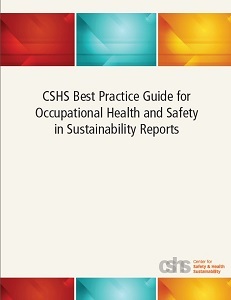Over the last several years, businesses have made sustainability a key part of their growth strategy. While most of the focus has been on environmental issues, attention is now turning to other aspects of sustainability, including occupational safety and health. This shift presents new opportunities for OSH professionals to advance the protection of workers. The Center for Safety and Health Sustainability has released a Best Practice Guide for Occupational Health and Safety in Sustainability Reports, which outlines a framework that can be used to incorporate occupational health and safety metrics into sustainability reporting practices. The guide was developed through a collaborative process that included some of the world's largest OSH professional organizations and represents standards of performance which are already accepted, understood, and operationalized by those managing safety and health at work. By using this guide to engage with business leaders OSH professionals can take a critical step in improving occupational safety and health performance and, ultimately, preventing worker injuries, illnesses and fatalities. For more information, read CSHS's news release.
OSHA and the National Oceanic and Atmospheric Administration have released a Lightning Safety When Working Outdoors Fact Sheet that provides employers and workers with information about lightning hazards and protective measures that can be taken to ensure workers’ safety. Often overlooked as an occupational hazard, lightning strikes can severely injure or kill workers in occupations such as construction, logging, utility repair, agriculture, telecommunications, lawn services, airport ground operations, and pool and beach lifeguarding.
 OSHA joins the National Safety Council and thousands of organizations across the country in recognizing June as National Safety Month. As part of an effort to emphasize the importance of safety both on and off the job, NSC's SafeForLife campaign highlights the leading causes of injury and death at work, on the roads, and in our homes and communities.Visit the SafeForLife website to take the SafeAtWork pledge and access downloadable materials including posters, tips sheets and games. You will also find a video,infographic and webinar taking place on June 14. A new NSC Safety Checkup web app provides a custom report on your specific safety risks.
OSHA joins the National Safety Council and thousands of organizations across the country in recognizing June as National Safety Month. As part of an effort to emphasize the importance of safety both on and off the job, NSC's SafeForLife campaign highlights the leading causes of injury and death at work, on the roads, and in our homes and communities.Visit the SafeForLife website to take the SafeAtWork pledge and access downloadable materials including posters, tips sheets and games. You will also find a video,infographic and webinar taking place on June 14. A new NSC Safety Checkup web app provides a custom report on your specific safety risks.
 OSHA has kicked off its summer campaign to inform employers and employees about the dangers of working in the heat. The campaign will continue its annual outreach to highlight how heat-related worker fatalities are entirely preventable. In 2014 alone, 2,630 workers suffered from heat illness and 18 diedfrom heat stroke and related causes on the job.
OSHA has kicked off its summer campaign to inform employers and employees about the dangers of working in the heat. The campaign will continue its annual outreach to highlight how heat-related worker fatalities are entirely preventable. In 2014 alone, 2,630 workers suffered from heat illness and 18 diedfrom heat stroke and related causes on the job.
On May 26, Kelly Schnapp, who directs OSHA's Office of Science and Technology Assessment, joined four other experts on a White House webinar highlighting the risks of extreme heat to four vulnerable populations: the elderly, athletes, emergency responders, and outdoor workers. Schnapp noted that a majority of recent heat-related deaths investigated by OSHA involved workers on the job for three days or less – highlighting the need for employers to ensure that new workers become acclimated to the heat when starting or returning to work.
OSHA also provided heat safety tips for workers in a blog, Twitter posts, and an updated heat campaign webpage that now includes illustrations of heat exhaustion and heat stroke, an animated video, training resources, and links to an updated heat safety phone app. #WaterRestShade is the official hashtag of the campaign, encouraging employers to provide their workers with drinking water, ample breaks, and a shaded area while working outdoors. OSHA also continues to partner with the National Oceanic and Atmospheric Administration to raise awareness on the dangers of working in the heat through its Weather-Ready Nation campaign.



